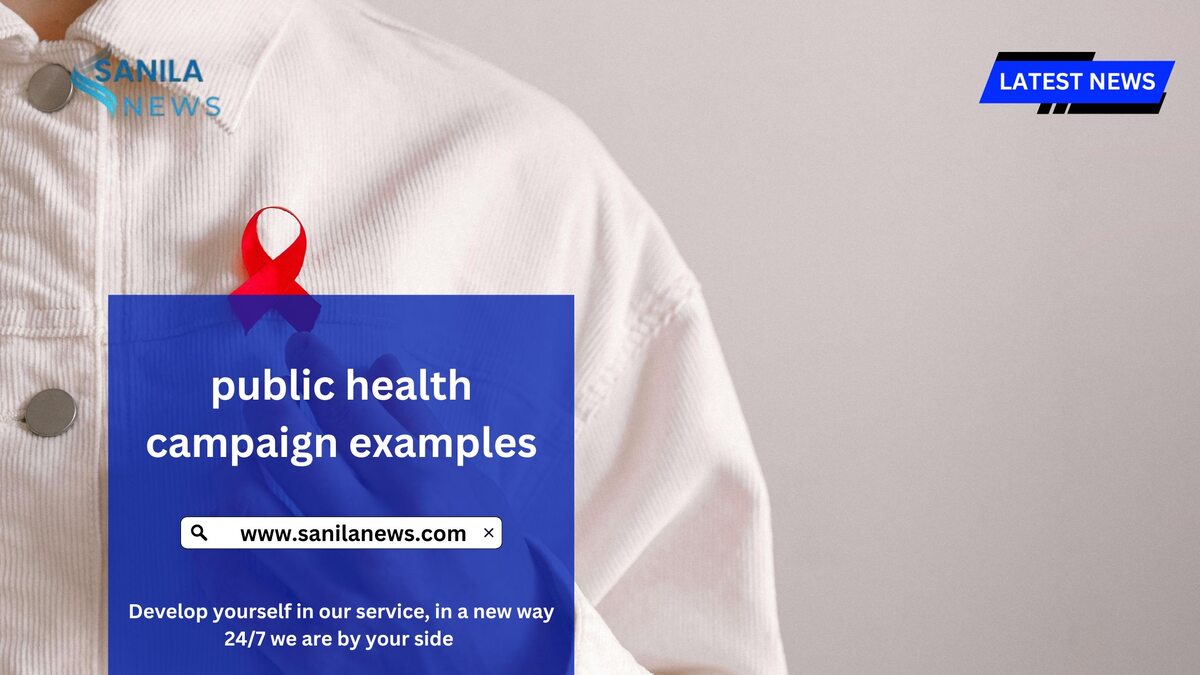Public Health Campaigns: Public health campaign examples a Comprehensive Guide with Examples:
Public health campaign examples play a crucial role in promoting the well-being of populations by raising awareness, changing behaviors, and encouraging healthier lifestyles. These campaigns are essential tools used by governments, non-governmental organizations, and public health institutions to address a wide range of health concerns. From preventing disease outbreaks to promoting mental health, public health campaigns have been influential in shaping modern societies’ health landscapes.
In this article, we will explore various public health campaigns, their strategies, impact, and notable examples. By delving into their core components, we can better understand how these campaigns have improved public health outcomes globally.
Key Elements of Public Health Campaigns
Public health campaign examples, regardless of their focus, share several common elements that contribute to their success:
- Clear Objectives: A successful campaign has a clearly defined goal. Whether it’s increasing vaccination rates, reducing smoking, or promoting mental health, the objective must be specific, measurable, and achievable.
- Target Audience: Identifying and understanding the target audience is critical for any public health campaign. Tailoring the message to specific groups ensures that it resonates and leads to effective behavioral change.
- Research-Based Strategies: Effective campaigns are based on solid research. This involves studying the behavior, attitudes, and preferences of the target population and understanding the health issue’s social, cultural, and economic factors.
- Message Clarity and Simplicity: The message must be clear, simple, and easy to understand. Over-complicated information or technical jargon can alienate the audience.
- Use of Multiple Channels: Successful campaigns utilize multiple platforms to spread their message. These channels can include television, radio, social media, billboards, pamphlets, and community outreach.
- Monitoring and Evaluation: Continuous monitoring and post-campaign evaluations help assess the effectiveness of the campaign, allowing for adjustments and future improvements.
Notable Public Health Campaigns and Their Impact
Below are some of the most successful public health campaigns from around the world, showcasing their objectives, strategies, and outcomes.
1. The Anti-Tobacco Campaign: “Truth” (U.S.)
Background: Public health campaign examples smoking was once heavily glamorized in advertising and media, despite the health risks associated with tobacco. The tobacco industry in the U.S. was targeted with several health campaigns over the years, but one of the most impactful was the “Truth” campaign.
Objective: The “Truth” campaign aimed to prevent smoking among teenagers by highlighting the manipulative tactics of the tobacco industry and the severe health risks associated with smoking.
Strategies:
- Youth-Centric Messaging: The campaign was crafted to resonate with teenagers, emphasizing rebellion against tobacco companies rather than focusing solely on the health impacts of smoking.
- Innovative Media Use: The campaign used television, print ads, social media, and events to reach its audience, ensuring a broad and sustained reach.
- Shock Factor: The campaign often used stark images and disturbing facts, such as showing the chemicals in cigarettes, to create a strong emotional response.
Impact: The “Truth” campaign is credited with reducing smoking rates among teenagers significantly. Between 2000 and 2016, the smoking rate among U.S. high school students fell from 23% to under 7%. The campaign’s long-term success has made it a model for other anti-tobacco efforts worldwide.
2. HIV/AIDS Awareness Campaign: “Knowing Is Beautiful” (Global)
Background: The global HIV/AIDS epidemic reached alarming proportions in the 1980s and 1990s, with millions of people worldwide affected. Early campaigns focused on raising awareness of the disease and promoting preventive measures like safe sex and the use of condoms.
Objective: Public health campaign examples the goal of the “Knowing Is Beautiful” campaign was to reduce the stigma surrounding HIV testing and encourage individuals to get tested for the virus.
Strategies:
- Focus on Empowerment: The campaign emphasized that getting tested for HIV is an empowering step toward taking control of one’s health.
- Celebrity Involvement: Public figures such as Bono, Alicia Keys, and Nelson Mandela became ambassadors for the campaign, helping to raise its profile.
- Widespread Media Coverage: The campaign utilized television, radio, billboards, and online platforms to reach a broad audience, particularly in high-risk areas.
Impact: The campaign helped normalize HIV testing and made strides in reducing the stigma surrounding the disease. HIV testing rates increased globally, and the campaign contributed to a larger cultural shift in how HIV/AIDS was discussed and understood.
3. Vaccination Campaign: “Get Vaccinated” (Global)
Background: Vaccination campaigns have been instrumental in eradicating or controlling diseases like smallpox, polio, and measles. In recent years, the focus has shifted to ensuring high coverage rates for childhood vaccinations and promoting flu and COVID-19 vaccines.
Objective: The primary aim of vaccination campaigns is to increase immunization rates, prevent disease outbreaks, and protect public health.
Strategies:
- Education and Awareness: Campaigns emphasize the importance of vaccines in preventing serious diseases. They often target parents, healthcare workers, and the general population to dispel myths and misinformation.
- Celebrity Endorsements and Influencers: Well-known figures, including actors and politicians, have endorsed vaccination campaigns, lending credibility and visibility.
- Incentives and Accessibility: Some campaigns offer free or reduced-cost vaccinations and set up mobile clinics to make vaccines more accessible in underserved areas.
Impact: Vaccination campaigns have been highly effective in increasing immunization rates and preventing diseases. For example, the global polio vaccination effort reduced the incidence of polio by more than 99% since 1988. More recently, COVID-19 vaccination campaigns have been critical in controlling the pandemic, saving millions of lives worldwide.
- The Mental Health Campaign: “Time to Change” (UK)
Background: Mental health issues have often been stigmatized, leading to people suffering in silence without seeking help. Mental health campaigns have focused on breaking down these barriers and encouraging people to talk about their mental health.
Objective: The “Time to Change” campaign aimed to reduce stigma and discrimination associated with mental health conditions, promoting open conversations and early intervention.
Strategies:
- Personal Stories: The campaign encouraged individuals with mental health conditions to share their stories, creating a sense of empathy and understanding among the public.
- Social Media and Online Platforms: The campaign used online platforms to engage younger audiences and spread messages about mental health in a non-intimidating and accessible way.
- Workplace Initiatives: The campaign partnered with employers to create mental health-friendly workplaces, offering resources and support for employees dealing with mental health issues.
Impact: Since its launch in 2007, the “Time to Change” campaign has made a significant impact on public attitudes toward mental health in the UK. Surveys indicated a notable reduction in mental health stigma, with more people feeling comfortable talking about their mental health. The campaign also inspired similar efforts in other countries, contributing to a global shift in how mental health is perceived.
- Obesity and Nutrition Campaign: “Change4Life” (UK)
Background: Obesity rates have been rising globally, leading to increased risks of heart disease, diabetes, and other health problems. Governments and health organizations have launched campaigns to promote healthy eating and physical activity to combat the obesity epidemic.
Objective: “Change4Life” aimed to reduce childhood obesity by encouraging healthier eating and more active lifestyles among families.
Strategies:
- Targeting Families: The campaign focused on parents and caregivers, providing them with practical tips and tools to improve their family’s diet and physical activity levels.
- Interactive Resources: The campaign’s website offered meal planners, recipes, and activity suggestions, making it easy for families to incorporate healthy changes into their daily lives.
- Partnerships: “Change4Life” partnered with schools, local authorities, and businesses to promote healthy lifestyles and support community-based initiatives.
Impact: The campaign has helped raise awareness of the importance of healthy eating and physical activity in reducing childhood obesity. It contributed to a broader societal conversation about nutrition and fitness, leading to more school-based health initiatives and changes in food labeling regulations in the UK.
- Road Safety Campaign: “Click It or Ticket” (U.S.)
Background: Car accidents remain one of the leading causes of death and injury worldwide. Seatbelt campaigns have been a key focus for public health efforts to reduce road traffic fatalities.
Objective: The “Click It or Ticket” campaign sought to increase seatbelt use and reduce the number of deaths and injuries from car accidents.
Strategies:
- Law Enforcement Support: The campaign involved collaboration with law enforcement agencies, which carried out seatbelt checks and issued fines to those not wearing seatbelts.
- Public Messaging: Television and radio ads highlighted the dangers of not wearing seatbelts and emphasized the legal consequences of non-compliance.
- Data-Driven Approach: The campaign used data on traffic accidents to target high-risk areas, ensuring that the message reached those most likely to benefit from it.
Impact: The “Click It or Ticket” campaign has been highly effective, leading to a significant increase in seatbelt usage across the U.S. Studies show that states with “Click It or Ticket” laws saw reductions in traffic fatalities and injuries, demonstrating the campaign’s success in changing behavior and saving lives.
Conclusion
Public health campaign examples are vital in addressing and preventing a wide range of health issues. The examples provided in this article show how thoughtful strategies, clear objectives, and targeted messaging can lead to positive health outcomes. Whether focused on
Last word
Keep an eye on our news channel Sanila News to get updated news regularly.

